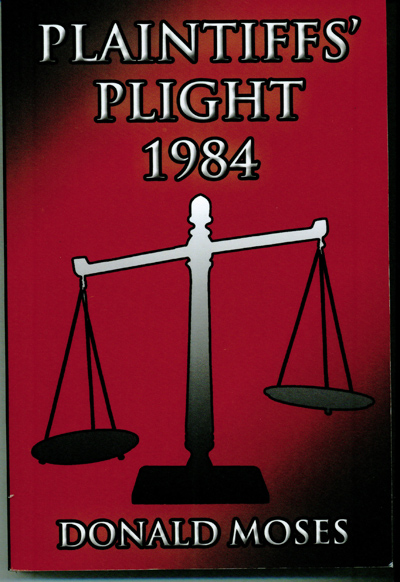Plaintiffs’ Plight 1984 by Donald Moses, Author House, 2009, ISBN 978-1-4490-2633-2, 362 pages,
By Donald H. Harrison

SAN DIEGO—A new solo practitioner has burst onto the literary legal scene: the meticulous but fictional lawyer Dan Masters, who not only has the same initials as the author but who, like him, is a San Diego-based attorney.
Masters is a trial lawyer, an advocate for the plaintiffs. With an invaluable secretary, a young bookkeeper and an inquisitive law school intern, he successfully manages to handle a formidable case load, sometime wishing that like television’s Perry Mason he only had to handle one case at a time.
 In this book, we get to follow four cases: a head-on collision that left the plaintiff paralyzed; a family dispute over a father’s will; a rear-end collision that caused the plaintiff whiplash, and an industrial accident that caused the plaintiff to lose his eye.
In this book, we get to follow four cases: a head-on collision that left the plaintiff paralyzed; a family dispute over a father’s will; a rear-end collision that caused the plaintiff whiplash, and an industrial accident that caused the plaintiff to lose his eye.
Plaintiffs’ Plight 1984 follows the twists and turns of these four cases, taking us through intake interviews, investigations, depositions, jury selection, courtroom tactics, verdicts and after-verdict maneuverings. The fictional Masters is methodical as he hunts down clues, precisely records facts (on floppy disks!) takes depositions, and prepares for trials. He is a good cross-examiner, giving defendants ample opportunity to make damaging mistakes in their testimony.
So, if you plan to become a lawyer—or, if like me, you enjoy such television franchises as Law and Order and CSI—you probably will like this book. Beware, however, that it has some of the common problems of first-time novels. While the plot is interesting, the characters often seem one-dimensional, mere accessories to the twists and turns of Masters’ career than flesh-and-blood people.
We know, for example, that Masters has a loving wife (who sometimes brings food into the office) and children, and that his work often keeps him at the office until well-past dinnertime. His wife is understanding, we are told. Can we assume that the children are as well? Do any conflicts arise as a result of Masters seeming always to put work first? Perhaps we will learn in future books.
As this book is Plaintiffs’ Plight 1984, my guess is that in the back of Moses’ mind, a sequel could be Plaintiffs’ Plight 1985 and that we could have the five books of Moses by the time he writes about fictional cases occurring in 1988. Perhaps as Moses, now retired from the law, develops as a novelist, he will weave for us not only the intricacies of the law but the complexities of life.
For San Diegans, there is much local color to enjoy—and even an occasional harmless mistake to make us sit up and wonder. (There are 18 incorporated cities in San Diego County, not 19}. My fellow Jews will appreciate occasional Jewish references in the narration.
Masters’ office is in Rancho Bernardo, the courtroom is in downtown San Diego. Moses enjoys describing in passing not only San Diego’s geography and fabled weather but also some of the area’s embarrassments, among them the J. David Dominelli arbitrage scandal.
Furthermore, Moses gives vent to his wide-ranging interests in discussions between Masters and two friends with whom he breakfasts or lunches each week. Did you know that there are some startling parallels between aspects of ancient North African culture and Mayan culture, leading to speculation that the two civilizations were related? Or that many of the people who changed and controlled the world throughout history were comparative youngsters?
Such discussions really have nothing to do with the plot of Plaintiffs Plight 1984, but they do enable Masters and readers to take enjoyable breaks from law cases for a minute or two.
*
Harrison is editor of San Diego Jewish World